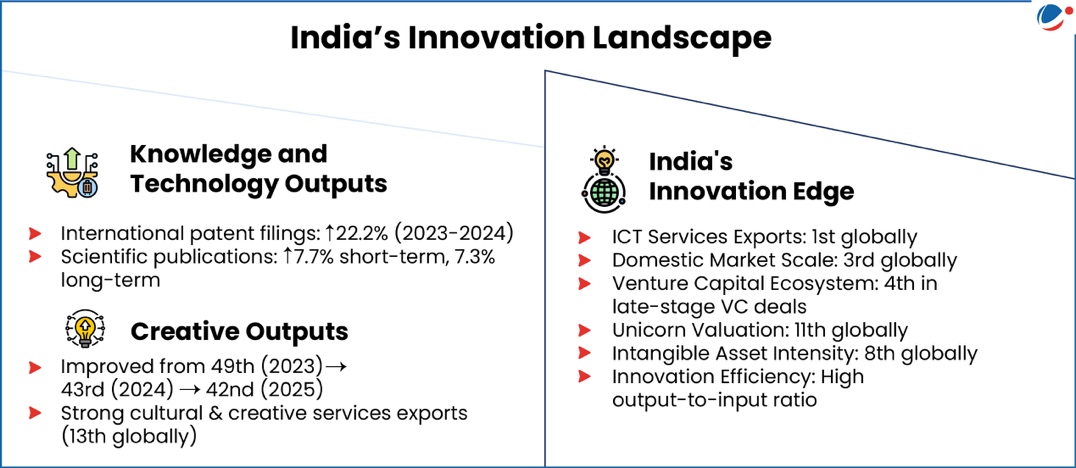Global Innovation Index (GII) 2025
World Intellectual Property Organisation released the Global Innovation Index (GII) 2025.
GII measures innovation performance of 139 economies through investment patterns, technological progress, adoption rates, and socioeconomic impacts.
- Launched in 2007, GII is recognized by the UN General Assembly as an authoritative reference for Science, Technology and Innovation (STI) policies.
Key Highlights of GII 2025
- India’s Rise: India’s rank rises to 38th position, a big leap from 81st in 2015.
- India along with Vietnam is the longest-standing overperformer, performing above expectation for their level of development for 15th year.
- Most Innovative Economies: Switzerland has been ranked first, followed by Sweden, USA, South Korea and Singapore.
- Top Innovation Clusters: Shenzhen–Hong Kong–Guangzhou (China and Hong Kong), followed by Tokyo-Yokohama (Japan), and San Jose-San Francisco (USA).
- India has four clusters in top 100: Bengaluru (21st), Delhi (26th), Mumbai (46th) and Chennai (84th).

India’s Initiatives for Improving Innovation
- Startup India Program: Provides handholding support for startups, funding through Fund of Funds, credit guarantee, tax exemptions etc.
- Atal Innovation Mission: Develop new programmes and policies for fostering innovation in different economic sectors.
- National Initiative for Developing and Harnessing Innovations (NIDHI): Umbrella programme for nurturing ideas into successful startups.
- Other: Accelerating Growth of New India's Innovations (AGNIi) Mission, NITI Frontier Tech Repository, Prime Minister’s Research Fellowship Scheme etc.
- Tags :
- Global Innovation Index (GII) 2025
Articles Sources
World Trade Report 2025
The report released by the World Trade Organization (WTO) recognizes the transformative potential of AI as a general-purpose technology that can reshape wealth distribution and income across economies.
How AI can act as catalysts for Trade and Inclusive Growth?
- Reducing Trade cost and improving productivity: By optimizing logistics, streamlining regulatory compliance, overcoming language barriers, and improving contract enforcement, AI could lead to 34-37% rise in global trade by 2040.
- Reducing ‘Skill Premium’: AI is expected to substitute tasks performed by medium- and high-skilled workers more than those of low-skilled workers, thereby reducing the relative demand for higher-skilled labor.
- Skill premium is the wage ratio of high-skilled to low-skilled workers which is projected to decline by 3-4% globally.
- Knowledge diffusion: Economies more open to trade experience stronger innovation spillovers - a 10% increase in digitally deliverable services trade is associated with a 2.6% rise in cross-border AI patent citations.
- New Development Pathways: Economies rich in critical minerals or renewable energy can become hubs for upstream inputs like hardware manufacturing or data hosting and other labor-intensive activities like data collection and annotation.
What are the concerns demanding urgent Policy action?
- Concentration of AI: AI development is highly concentrated in a few firms and economies, which poses risks to equitable access.
- Labor market disruption: Displacement of some workers by automating tasks, requiring investment in education and active labor market policies to help workers adapt.
Conclusion
To realize the inclusive potential of AI and trade, there is a need for proactive and coordinated policies, including investing in digital infrastructure and skills, promoting regulatory coherence, ensuring competition, and leveraging international cooperation through organizations like the WTO.
- Tags :
- World Trade Report 2025
Articles Sources
OECD Economic Outlook Report
OECD Upgrades India’s 2025 GDP Forecast to 6.7% While Moderating Inflation Projection to 2.9%.
About Economic Outlook Report
Released by: Organisation for Economic Co-operation and Development (OECD)
- Report: Biannual publication analyzing global and national economic trends.
- Coverage: Includes GDP, inflation, employment, trade, and investment.
- Risks: Highlights inflationary pressures, financial instability, and geopolitical tensions.
- Tags :
- OECD Economic Outlook Report



